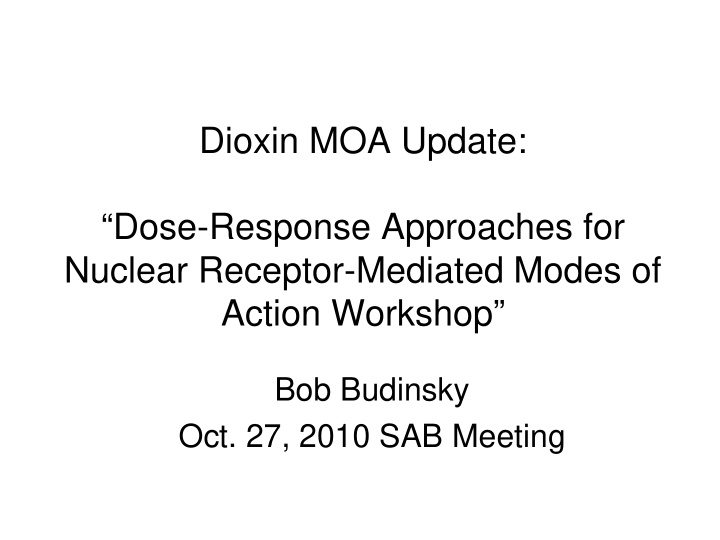



Dioxin MOA Update: “Dose-Response Approaches for Nuclear Receptor-Mediated Modes of Action Workshop” Bob Budinsky Oct. 27, 2010 SAB Meeting
July 13 Comments on MOA • EPA incorrectly rejected the MOA • EPA failed to follow their own MOA Framework Guidance (2005 Cancer Guidelines) • Dioxin-induced carcinogenicity in rodents is a biologically based, threshold phenomenon • Clarification: MOA should not be confused with mechanism
Nuclear Receptor MOA Workshop • Sept 27-29 th at NIEHS • Meeting Chairs: Julian Preston (EPA) and Mel Andersen (Hamner Institute) • Purpose: To assess MOA and dose- response modeling of nuclear receptors • 3 Case Studies: CAR/PXR, PPAR α , and AHR
AHR Expert Panel Members Chairs: Dieter Schrenk ( Univ. of Kaiserlautern ) and Bob Budinsky ( Dow Chemical ) • Bruce Allen (Allen Consulting) • Tom Starr (TBS) • Lesa Aylward (SummitToxicology) • Jay Silkworth (General Electric) • Amy Brix (EPL) • Nigel Walker (NIEHS) • Tom Gasiewicz (Univ. of • Martin van den Berg (Univ. of Rochester) • Norb Kaminski (Mich State) Uetrecht) • Presenters • Gary Perdew (Penn State) • Ted Simon (Ted Simon, L.L.C.) – Craig Rowlands (Dow) – Rusty Thomas (Hamner) – Mel Andersen (Hamner) Andy Maier (TERA): Rapporteur
Sustained AHR Sustained AHR Ligand Activation Activation Hepatocytes Billiary Cells Spontaneously Spontaneously Biliary Initiated Initiated Biliary Fibrosis Hepatocytes Cells Increased Proliferation Increased Decreased Proliferation Apoptosis Initiated Biliary Foci Cells Increased Proliferation Increased Proliferation Decreased Apoptosis Tumors Tumors Associative Events Associative Events Multinucleated Associative Event Hepatocytes Oval cell XME Induction hyperplasia Oval cell hyperplasia Inflammation
Dose Response Example: Hepatocellular Cancer Key Event Multinucleated Hepatocyte RfD: 2 – 70 pg/kg/day (UFs: 1.0 – 30) Hepatocellular Cancer RfD: 20 to 600 pg/kg/day (UFs: 1.0 – 30) based on Simon et al., 2009
Dose Response Example: Biliary Cancer Key Event Oval Cell Hyperplasia RfD: 0.8 to 20 pg/kg/day (UFs: 1.0 – 30) Biliary Duct Cancer RfD: 10 to 300 pg/kg/day (UFs: 1.0 – 30) based on Simon et al., 2009
Summary • A MOA can be established for dioxin by applying the IPCS and 2005 EPA MOA Framework – this was done in the Nuclear Receptor-MOA workshop • Significant number of dose-response studies for Key Events and Associative Events • Threshold nature of sustained AHR-activation culminating in Key Events and Associative Events leading to liver tumors in rats and mice.
Recommend
More recommend